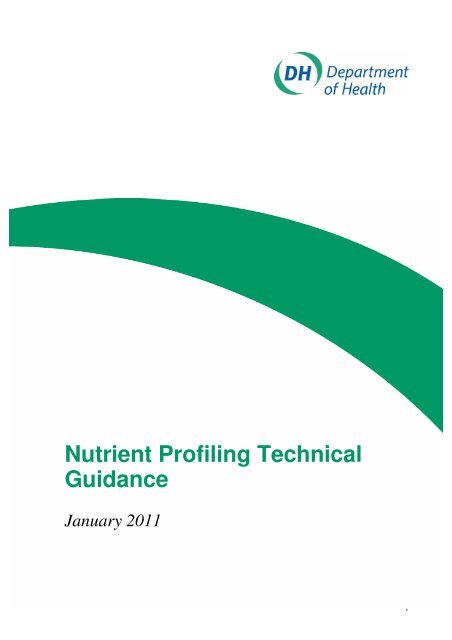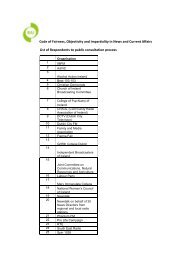Nutrient Profiling Technical Guidance - Gov.uk
Nutrient Profiling Technical Guidance - Gov.uk
Nutrient Profiling Technical Guidance - Gov.uk
You also want an ePaper? Increase the reach of your titles
YUMPU automatically turns print PDFs into web optimized ePapers that Google loves.
<strong>Nutrient</strong> <strong>Profiling</strong> <strong>Technical</strong><strong>Guidance</strong>January 20111
<strong>Nutrient</strong> <strong>Profiling</strong> <strong>Technical</strong> <strong>Guidance</strong> January 2011Title<strong>Nutrient</strong> <strong>Profiling</strong> <strong>Technical</strong> <strong>Guidance</strong>AuthorDepartment of HealthPublication Date 01 Jan 2011Document PurposeTarget AudienceDescriptionSuperseded DocsFor InformationFood manufacturers, retailers and advertisersThe guidelines set out in this document have been produced to assist foodmanufacturers, retailers and advertisers to correctly calculate nutrientprofiling scores for their products. This document aims to answer questionsabout the application of the model to different types of products.<strong>Nutrient</strong> <strong>Profiling</strong> <strong>Technical</strong> <strong>Guidance</strong> April 2009 (FSA)Contact DetailsObesity TeamDepartment of Health7th floor, South Wing, Wellington House133-155 Waterloo RoadSE1 8UG© Crown copyright Year 2011Published to DH website, in electronic PDF format only.http://www.dh.gov.<strong>uk</strong>/publications2
<strong>Nutrient</strong> <strong>Profiling</strong> <strong>Technical</strong> <strong>Guidance</strong> January 2011ContentsThe <strong>Nutrient</strong> <strong>Profiling</strong> Model................................................................................................... 41. Application of the Agency’s <strong>Nutrient</strong> <strong>Profiling</strong> Model.......................................................... 52. How to Calculate Scores for the Fruit, Vegetable and Nut Content of Food and Drink ...... 73. Frequently Asked Questions ............................................................................................ 104. Worked Examples............................................................................................................ 143
<strong>Nutrient</strong> <strong>Profiling</strong> <strong>Technical</strong> <strong>Guidance</strong> January 2011<strong>Nutrient</strong> <strong>Profiling</strong> <strong>Technical</strong> <strong>Guidance</strong>The guidelines set out in this document have been produced to assist food manufacturers,retailers and advertisers to correctly calculate nutrient profiling scores for their products.This document aims to answer the frequently asked questions about the application of themodel to different types of products through a simple guide, Q&A section and workedexamples.The <strong>Nutrient</strong> <strong>Profiling</strong> ModelThe nutrient profiling model was developed by the Food Standards Agency (FSA) in 2004-2005 to provide Ofcom, the broadcast regulator, with a tool to differentiate of foods on thebasis of their nutritional composition, in the context of television advertising foods to children.The model uses a simple scoring system where points are allocated on the basis of thenutrient content of 100g of a food or drink. Points are awarded for ‘A’ nutrients (energy,saturated fat, total sugar and sodium), and for ‘C’ nutrients (fruit, vegetables and nut content,fibre and protein). The score for ‘C’ nutrients is then subtracted from the score for ‘A’ nutrientsto give the final nutrient profile score.Foods scoring 4 or more points, and drinks scoring 1 or more points, are classified as ‘lesshealthy’ and are subject to Ofcom’s controls on the advertising of foods to children on TV.The model applies equally to all food and drink; there are no exemptions or category-specificcriteria.4
<strong>Nutrient</strong> <strong>Profiling</strong> <strong>Technical</strong> <strong>Guidance</strong> January 20111. Application of the Agency’s <strong>Nutrient</strong> <strong>Profiling</strong> ModelThere are 3 steps to working out the overall score of a food or drink.1. Work out total 'A' pointsA maximum of ten points can be awarded for each nutrient.Total 'A' points = (points for energy) + (points for saturated fat) + (points for sugars) + (pointsfor sodium)The following table indicates the points scored, depending on the amount of each nutrient in100g of the food or drink:Points Energy (kJ) Sat Fat (g) Total Sugar (g) Sodium (mg)0 ≤ 335 ≤ 1 ≤ 4.5 ≤ 901 >335 >1 >4.5 >902 >670 >2 >9 >1803 >1005 >3 >13.5 >2704 >1340 >4 >18 >3605 >1675 >5 >22.5 >4506 >2010 >6 >27 >5407 >2345 >7 >31 >6308 >2680 >8 >36 >7209 >3015 >9 >40 >81010 >3350 >10 >45 >900If a food or drink scores 11 or more ‘A’ points then it cannot score points for protein unless italso scores 5 points for fruit, vegetables and nuts.2. Work out total 'C' pointsA maximum of five points can be awarded for each nutrient/food component.Total 'C' points = (points for % fruit, vegetable & nut content) + (points for fibre [either NSP orAOAC]) + (points for protein)The following table indicates the points scored, depending on the amount of each nutrient/foodcomponent in 100g of the food or drink:Points Fruit, Veg & Nuts (%) NSP Fibre ' (g) Or AOAC Fibre ' (g) Protein (g)0 ≤ 40 ≤ 0.7 ≤ 0.9 ≤ 1.61 >40 >0.7 >0.9 >1.62 >60 >1.4 >1.9 >3.23 - >2.1 >2.8 >4.84 - >2.8 >3.7 >6.45* >80 >3.5 >4.7 >8.05
<strong>Nutrient</strong> <strong>Profiling</strong> <strong>Technical</strong> <strong>Guidance</strong> January 20113. Work out overall score• If a food scores less than 11 ‘A’ points then the overall score is calculated as follows:Total ‘A’ points (energy + saturated fat + sugars + sodium)MinusTotal ‘C’ points (fruit, veg and nuts + fibre + protein)• If a food scores 11 or more ‘A’ points but scores 5 points for fruit, vegetables and nuts thenthe overall score is calculated as follows:Total ‘A’ points (energy + saturated fat + sugars + sodium)MinusTotal ‘C’ points (fruit, veg and nuts + fibre + protein)• If a food scores 11 or more ‘A’ points, and less than 5 points for fruit, vegetables and nuts,then the overall score is calculated as follows :Total ‘A’ points (energy + saturated fat + sugars + sodium)MinusPoints for fibre + points for fruit, vegetables and nuts (not allowed to score for protein)A food is classified as 'less healthy' where it scores 4 points or more.A drink is classified as 'less healthy' where it scores 1 point or more.6
<strong>Nutrient</strong> <strong>Profiling</strong> <strong>Technical</strong> <strong>Guidance</strong> January 20112. How to Calculate Scores for the Fruit, Vegetable and Nut Content of Food andDrinkThis section provides guidance on how to calculate the fruit, vegetable and nut content of aproduct, for the purpose of calculating a nutrient profiling score. More detailed information canbe found at:http://www.food.gov.<strong>uk</strong>/multimedia/pdfs/nutprofpguide.pdfDefinition of Fruit and VegetablesThe definition for the 5 A DAY programme should be used for fruit and vegetables. Potatoesand other starchy vegetables such as yams do not count.What Counts and What Doesn’tThe beneficial effects of fruits and vegetables are associated with the whole product, ratherthan components extracted from it. For this reason only intact fruit and vegetables (includingthose that are cooked and dried) and those that are minimally processed (peeled, sliced,tinned, frozen, juices* and purees) can be included when calculating a score.Fruit and vegetables that have been subject to further processing (e.g. concentrated fruit juicesugars, powders or leathers) do not count.*see section on fruit juice below.Definition of ‘Nuts’ for the Purpose of Calculating a <strong>Nutrient</strong> <strong>Profiling</strong> ScoreAll nuts (including peanuts) are included in the definition of ‘nuts’.In the case of coconut, the following apply:• Fresh coconut flesh should be scored as fruit;• The water in the centre of the coconut should be scored as fruit juice;• The juice squeezed from the flesh (coconut milk) should be scored as fruit juice;• Desiccated and dried block coconut should be scored as dried fruit (see section on driedand pureed fruit and vegetables);• Coconut which is processed beyond the original product being juiced or dried should not beincluded.Seeds, except those commonly regarded as nuts (e.g. brazil nuts, cashew nuts), are notincluded.Dried and Pureed Fruit and VegetablesSmaller amounts of dried fruits and vegetables are equivalent to one standard portion of freshfruit or vegetables. Therefore when calculating a score, the weight of dried fruit and vegetablesshould be multiplied by 2 (see worked example 5).This principle should also be applied to commercially prepared concentrated tomato puree.7
<strong>Nutrient</strong> <strong>Profiling</strong> <strong>Technical</strong> <strong>Guidance</strong> January 2011Fruit Juice100% fruit juice, whether freshly squeezed or made from concentrate, is regarded as minimallyprocessed. It should count for the purposes of calculating a score (see worked example 6).To score points for fruit and vegetables, the portion of the product composed of fruit juice mustbe 100% fruit juice (whether freshly squeezed or made from concentrate). The amount ofpoints scored for fruit, vegetables and nuts depends on the percentage of 100% fruit juice inthe product:• Where a product is 100% fruit juice it would score 5 points for fruit, vegetables and nuts.• A product that is 84% juice (juice is 100% fruit juice from concentrate) would score 5 forfruit, vegetables and nuts as it has a content of >80% fruit juice.• A product that is 56% juice (where juice is 100% juice from concentrate) would only score 1point (see scoring system below).• Fruit juice products containing 40% or less fruit juice (where juice is 100% fruit juice fromconcentrate or otherwise) are not eligible to score points (see worked example 6).Concentrated fruit juice sugars, powders or leathers should not count for the purposeof calculating a score.Scoring systemPoints Fruit, vegetablesand nut content0 ≤ 40%1 > 40%2 > 60%3 -4 -5 > 80%Calculating Score Before or After CookingThe amount of fruit and vegetables in a product can be calculated before or after cooking.However, when calculating the amount in a composite food, all the ingredients should be in thesame state (either raw or cooked).8
<strong>Nutrient</strong> <strong>Profiling</strong> <strong>Technical</strong> <strong>Guidance</strong> January 2011CalculationThe amount (%) of fruit, vegetables or nuts in 100g of a product is calculated as follows:(Weight of f,v&n) + (2 x weight of dried f,v&n*)X 100(weight of f,v&n) + (2 x weight of dried f,v&n) + (weight of other ingredients)Keyf = fruitv = vegetablesn = nuts*dried fruit, vegetables and nuts includes tomato puree.9
<strong>Nutrient</strong> <strong>Profiling</strong> <strong>Technical</strong> <strong>Guidance</strong> January 20113. Frequently Asked QuestionsThis section is intended to answer the various questions that have been raised by stakeholdersregarding the application of the nutrient profiling model to various food types. If you can notfind the information you require you should contact DH directly.Questionsa. Should I use NSP or AOAC fibre values to calculate a nutrient profiling score?b. How do I calculate a nutrient profile score for a product consumed in quantities less than100 grams (g)?c. How do I calculate a nutrient profile score for breakfast cereals?d. How do I calculate a nutrient profile score for a product which is measured by volume, e.g.ice cream, which is usually measured in millilitres (ml’s)?e. Should I calculate nutrient profile scores for products as sold or as consumed?f. How do I calculate a nutrient profile score for drinks which need to be reconstituted (e.g.squash, milkshake powder or syrup, hot chocolate powder, cocoa powder, malted milkpowder)?g. How do I calculate a nutrient profile score for powdered or ready-made soups?h. How do I calculate a nutrient profile score for dried pasta, noodles or dried rice products?i. How do I calculate a nutrient profile score for milk?j. How do I calculate a nutrient profile score for yogurt drinks?k. What should I do if my product is reformulated after submitting my nutrition profile certificateto Clearcast?10
<strong>Nutrient</strong> <strong>Profiling</strong> <strong>Technical</strong> <strong>Guidance</strong> January 2011Answersa. Should I use NSP or AOAC fibre values to calculate a nutrient profile score?The nutrient profiling model was developed using UK recommendations for NSP fibre intake,as measured using the Englyst method. The nutrient profiling score should therefore becalculated using the NSP fibre value, where this is known. Where the NSP value is not known,AOAC fibre values can be used.Scoring systemPoints NSP(g) AOAC(g)0 ≤ 0.7 ≤ 0.91 > 0.7 > 0.92 > 1.4 > 1.93 > 2.1 > 2.84 > 2.8 > 3.75 > 3.5 > 4.7b. How do I calculate a nutrient profile score for a product consumed in quantities lessthan 100 grams (g)?The nutrient profile score is always calculated per 100g, irrespective of the amount of productwhich is consumed (see worked example 1). Amounts of nutrients must be multiplied up to theamount in the product per 100g.c. How do I calculate a nutrient profile score for breakfast cereals?The nutrient profile score for breakfast cereals should be calculated on 100g of the product assold, on a dry weight basis.d. How do I calculate a nutrient profile score for a product which is measured byvolume, e.g. ice-cream, which is usually measured in millilitres (ml’s)?<strong>Nutrient</strong> profile scores are calculated per 100g of product. If available information is per100ml’s, this should be converted to per 100g using the appropriate specific gravity (density) ofthe product (see worked example 2).e. Should I calculate nutrient profile scores for products as sold or as consumed?<strong>Nutrient</strong> profile scores should usually be calculated for a product as sold. In cases where aproduct needs to be reconstituted before it is eaten, for example custard powder, the nutrientprofile score should be calculated based on 100g of the product as reconstituted according tothe manufacturers instructions.f. How do I calculate a nutrient profile score for drinks which need to be reconstituted(e.g. squash, milkshake powder or syrup, hot chocolate powder, cocoa powder,malted milk powder)?The nutrient profile score should be calculated based on 100g of the drink as reconstitutedaccording to the manufacturers instructions (see worked example 3).11
<strong>Nutrient</strong> <strong>Profiling</strong> <strong>Technical</strong> <strong>Guidance</strong> January 2011g. How do I calculate a nutrient profile score for powdered or ready-made soups?Soups are classified as food for the purposes of the model.If the soup is powdered, it should be reconstituted according to the manufacturer’s instructionsand the nutrient profile score calculated on the nutritional composition of 100g of made-upsoup (see worked example 4).If the soup is ready made, the score should be calculated based on the nutritional compositionof 100g of the ready made soup.h. How do I calculate a nutrient profile score for dried pasta, noodles or dried riceproducts?The nutrient profile score for dried pasta, noodles, dried rice and other foods which requirereconstitution prior to consumption should be calculated on the basis of the nutritionalcomposition per 100g of the reconstituted product according to the manufacturer’s instructions(see worked example 4).i. How do I calculate a nutrient profile score for milk?<strong>Nutrient</strong> profiling scores for whole, semi-skimmed and skimmed milk should be determined onthe basis of the composition values provided within McCance and Widdowson’s, TheComposition of Foods 2002, Sixth Summary Edition, which take account of seasonal andgeographical variability in nutritional components of milk, and represent a variety of processingtreatments (pasteurised, sterilised and UHT milk varieties).In the case of whole milk, the value for whole milk average should be used.In the case of semi-skimmed milk, the value for semi-skimmed milk average should be used.In the case of skimmed milk, the value for skimmed milk average should be used.In the case of standardised whole milk, which has a slightly lower fat content than whole milk,where McCance and Widdowson does not give values, the whole milk average should be usedadjusted for fat content.12
<strong>Nutrient</strong> <strong>Profiling</strong> <strong>Technical</strong> <strong>Guidance</strong> January 2011j. How do I calculate a nutrient profile score for drinking yogurts?For the purposes of nutrient profiling, a ‘drinking yogurt’ is a product that meets the industrycompositional standards for yogurt, with no additional liquids (e.g. milk, fruit juice or water).These products should be profiled as foods.Products that consist of yogurt mixed with additional liquids are considered ‘yogurt drinks’,and these should be profiled as drinks.k. What should I do if my product is reformulated after submitting my nutrition profilecertificate to Clearcast?If, following submission of your nutrition profile certificate to Clearcast your product undergoesreformulation and the nutrient profile score changes, a revised certificate should be submittedto Clearcast for consideration.13
<strong>Nutrient</strong> <strong>Profiling</strong> <strong>Technical</strong> <strong>Guidance</strong> January 20114. Worked ExamplesThis section works through how to calculate nutrient profiling scores in various scenarios andfor different types of products.Worked example 1: Calculating a score for a product sold in a portion size
<strong>Nutrient</strong> <strong>Profiling</strong> <strong>Technical</strong> <strong>Guidance</strong> January 2011Worked example 2: Calculating a score for a product where nutrient information isprovided in mls rather than gramsProduct:Vanilla ice-cream.Products sold in mls should be converted to per 100g using the appropriate specific gravity(density) of the product.• Multiply nutrition information per 100ml by 0.55* to give nutrition information in grams.• Calculate score using per 100g information.Nutritioninformationper 100mlice-creamNutritioninformationper 100gice-cream**ScoreEnergy (kJ) 1347 741 2Saturated fat (g/100g) 11.1 6.1 6Total sugar (g/100g) 34.0 18.7 4Sodium (mg/100g) 109.1 60 0Total A points - - 12Fruit, veg, nuts (%) 0 0 0NSP fibre (g/100g) 0 0 0Protein (g/100g) 6.5 3.6 0***Total C points - - 0SCORE: A-C - - 12* Specific gravity of ice-cream = 0.55, taken from: ‘Food Portion Sizes’ Third Ed** Nutrition information from vanilla dairy ice-cream, McCance & Widdowson’s The Composition of Foods, 6 th Summary Ed.*** Product not eligible to score points for protein as it scores a total of 12 ‘A’ pointsThis ice-cream scores 12 and so would be subject to advertising restrictions.15
<strong>Nutrient</strong> <strong>Profiling</strong> <strong>Technical</strong> <strong>Guidance</strong> January 2011Worked example 3: Calculating a score for a drink that requires reconstitution beforeconsumptionProduct:Powdered milkshake (instructions for reconstitution provided on pack are15g of powder and 200mls of semi-skimmed milk).• A – use nutrition info for powder for 15g of product• B – calculate weight (g) of 200ml of semi skimmed milk• C – add together nutrient info for 15g powder and 206.8g milk together• D – scale down from 221g (15g + 206.8g) to per 100g by dividing by 2.218A B C D15gmilkshakepowder200ml x0.034* =206.8g semiskimmed milk15g powder+ 206.8gmilk15g powder +206.8g milkscaled downto 100gEnergy (kJ) 247 417 664 299 0Saturated fat (g/100g) 0 2.3 2.3 1.0 0Total sugar (g/100g) 14.7 5 19.7 8.9 1Sodium (mg/100g) 0 91 91 41 0Total A points - - - - 1Fruit, veg, nuts (%) 0 0 0 0 0AOAC fibre (g/100g) 0 0 0 0.5 0Protein (g/100g) 0 7 7 3.2 1Total C points - - - - 1SCORE: A-C - - - - 0* Specific gravity of semi-skimmed milk = 0.034, taken from: ‘Food Portion Sizes’ Third EdThis milkshake scores 0 and so would not be subject to advertising restrictions.Score16
<strong>Nutrient</strong> <strong>Profiling</strong> <strong>Technical</strong> <strong>Guidance</strong> January 2011Worked example 4: Calculating a score for a food that requires reconstitution beforeconsumptionProduct:Cup soup, tomato flavour (instructions for reconstitution provided on pack are25g of soup powder and 230ml of water).• Use nutrition info for 25g of product• No calculation for weight of water needed (1ml = 1g)• Add together 25g soup powder and 230g water• Scale down nutrition info from 255g (25g + 230g) to per 100g by diving it by 2.55Per 25g souppowder and230ml water*Nutritioninformationscaled down to100gScoreEnergy (kJ) 395 155 0Saturated fat (g/100g) 0.9 0.4 0Total sugar (g/100g) 9.2 3.6 0Sodium (mg/100g) 1200 471 5Total A points - - 5Fruit, veg, nuts (%) 0 0 0AOAC fibre (g/100g) 0.5 0.2 0Protein (g/100g) 0.8 0.3 0Total C points - - 0SCORE: A-C - - 5* 1ml of water is equivalent to 1g hence no density calculation requiredThis cup soup scores 5 and so would be subject to advertising restrictions.17
<strong>Nutrient</strong> <strong>Profiling</strong> <strong>Technical</strong> <strong>Guidance</strong> January 2011Worked example 5: Calculating a score for a product containing dried fruitProduct:Fruit and nut cereal bars.Contains dried fruit (30g/100g).Using fruit, vegetables and nuts calculation (page 4) this product contains 46 % fruit, veg andnuts:(Weight of f,v&n) + (2 x weight of dried f,v&n*)(weight of f,v&n) + (2 x weight of dried f,v&n) + (weight of other ingredients) X 100• Weight of f,v&n = 0• Weight of dried f,v&n = 30• Weight of other ingredients 70• Calcultation: 60 (2 x 30) ÷ 130 (60 + 70) x 100 = 46%Per 40g bar Per 100g ScoreEnergy (kJ) 602 1504 4Saturated fat (g/100g) 0.6 1.4 1Total sugar (g/100g) 14.3 35.7 7Sodium (mg/100g) 0 0 0Total A points - - 12Fruit, veg, nuts (%) 46% 46% 1AOAC fibre (g/100g) 1.9 4.8 5Protein (g/100g) 1.7 4.3 0*Total C points - - 6SCORE: A-C - - 6* Product not eligible to score points for protein as it scores a total of 12 ‘A’ pointsThis cereal bar scores 6 and so would be subject to advertising restrictions.Worked example 6: Calculating a score for a fruit juice drinkProduct:Raspberry and cranberry juice drink.Contains cranberry juice from concentrate (10%) and raspberry juice fromconcentrate (5%).Per 100ml Per 100g* ScoreEnergy (kJ) 177 184 0Saturated fat (g/100g) 0 0 0Total sugar (g/100g) 9.9 10.3 2Sodium (mg/100g) 0 0 0Total A points - - 2Fruit, veg, nuts (%) 15% 15% 0AOAC fibre (g/100g) 0 0 0Protein (g/100g) 0.1 0.1 0Total C points - - 0SCORE: A-C - - 2*Specific gravity of mixed fruit juice drink 1.04This fruit juice drink scores 2 and so would be subject to advertising restrictions.18






